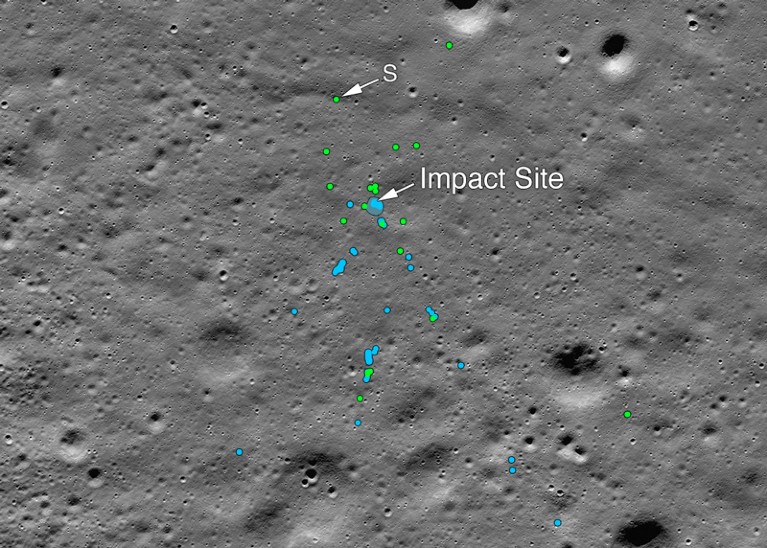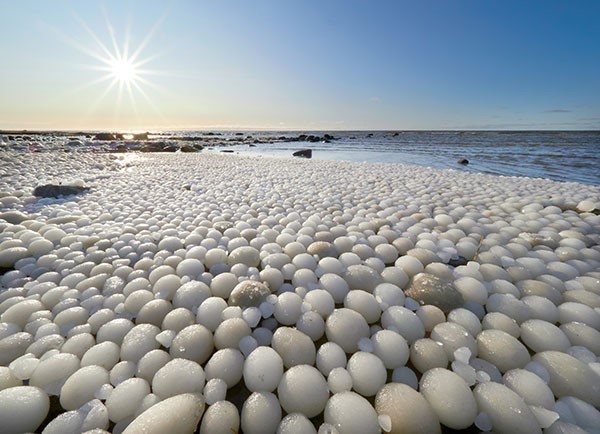Hello Nature readers, would you like to get this Briefing in your inbox free every day? Sign up here

Green dots indicate confirmed or likely spacecraft debris, while blue dots show disturbed soil. "S" is the debris identified by Shanmuga Subramanian.Credit: NASA/Goddard/Arizona State University
Amateur finds crashed Indian Moon lander
Images from NASA’s Lunar Reconnaissance Orbiter have confirmed the final resting place of India’s Moon lander, Vikram. The Indian Space Research Organisation lost contact with the craft just moments before it was supposed to touch down on 7 September. Space enthusiast Shanmuga Subramanian initially spotted the debris in publicly available images released by the orbiter team.
Watch an interview with Subramanian exploring how he made the discovery (IndiaToday)
The unpublished CRISPR-babies papers
MIT Technology Review, which broke the news of biophysicist He Jankui’s controversial claim that he helped make the world’s first genome-edited babies, has published excerpts from He’s draft papers on the research.
It also explores why the study was never published in any journal or on the bioRxiv repository — and might never be, for ethical reasons, and because He has not been seen or heard from for months.
Medical researcher Kiran Musunuru, who saw the papers before the scandal broke last year, argues that the research “reveals serious, unresolved safety concerns” and compares the work to the most egregious ethical breaches in science’s history.
MIT Technology Review | 20 min read
Iron-rich rocks that formed during the ice ages reveal that oases of oxygen persisted just beneath the ancient ice sheets. During the ‘Snowball Earth’ period, from about 720 million to 635 million years ago, ice sealed off the seas in a way that should have depleted life-giving oxygen in the water — but didn’t. Researchers say that rusty rocks indicate there was oxygen in the water near the edges of continents, possibly thanks to meltwater streams containing bubbles of air.
The New York Times | 4 min read
Features & opinion
Did rain jump-start dinosaur evolution?
About 232 million years ago, after millions of years of dry climates, it started to rain. During a span known as the Carnian age, a couple of million years of warm, wet weather seems to have have profoundly altered life on Earth and paved the way for dinosaurs including Stegosaurus and Tyrannosaurus. “One of the fascinating things about this interval is how many modern groups appear, from vertebrates all the way down to plankton,” says palaeontologist Paul Wignall.
Stop state-level surveillance of DNA
Predominantly US and European corporations selling DNA-profiling technology are aiding human-rights abuses — most strikingly in China, argues computational biologist Yves Moreau. Moreau outlines how governments, legislators, researchers, reviewers and publishers can act now to reduce the likelihood of massive DNA databases being misused.
How climate models tell our fortunes
The world’s supercomputers are revving up to run the next generation of climate models in a bid to predict the future of our planet. Their projections will inform the influential Intergovernmental Panel on Climate Change (IPCC) report, coming in 2021. Discover how the 100 or so distinct climate models, produced by 49 research groups, are becoming ever more sophisticated.
Image of the week

Risto Matilla, an amateur photographer, took this picture of thousands of rare ‘ice eggs’ on a beach in Finland. Meteorologist Jouni Vainio says the balls form when slushy water freezes on rocky cores in the icy air and are rolled around by a low swell. (The Guardian)Risto Mattila
